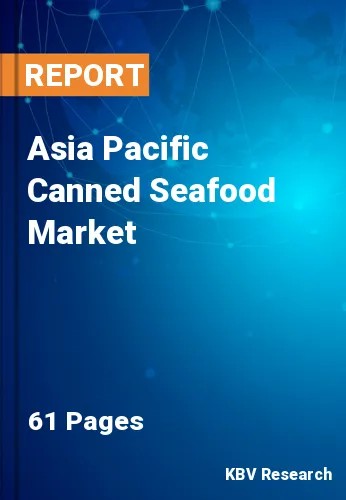The Asia Pacific Canned Seafood Market would witness market growth of 5.8% CAGR during the forecast period (2022-2028).
Higher consumption of canned seafood is anticipated as demand for high-shelf-life sea items rises. In addition, rising disposable income and shifting customer preferences for ready-to-eat meals are expected to be the key drivers of market expansion in the coming years. The industry is expected to rise due to the growing population consuming seafood due to its high health advantages, Due to a significant increase in disposable incomes, changing standards of life, and convenience.
Canned tuna is a healthy dinner or lunch option because it is high in protein and low in fat. It also contains omega-3 fatty acids, which can help to enhance blood vessel function, lower blood pressure, and lower the risk of cardiovascular disease. Depending on what they're canned in, canned tuna can be high in salt. As people are becoming more health-conscious, they also prefer to gain knowledge about what are they eating. hence, market players are also mentioning the ingredients along with their proportions. People are more tend to prefer one with less than 400mg per 100g.
The Asia Pacific is expected to witness an increase in canned seafood product adoption due to the enormous amount of raw material available and the big number of aquaculture canneries in the region. Additionally, the Asia Pacific market would be driven by the ever-increasing demand for ready-to-cook seafood products in emerging economies. The presence of some of the most well-known canned seafood brands would help the regional market grow even further. New seafood products are being developed in response to the increased popularity of dining in bars, cafes, and restaurants. The increased demand for shelf-stable foods in such channels would augur well for the regional market. Japan's demand for canned salmon is significantly high due to its high seafood consumption. The rapidly surging demand for protein-based food items among health-conscious customers in the country is one of the primary drivers for the regional canned seafood market.
The China market dominated the Asia Pacific Canned Seafood Market by Country in 2021, and would continue to be a dominant market till 2028; thereby, achieving a market value of $5,363.2 Million by 2028. The Japan market is anticipated to grow at a CAGR of 5.2% during (2022 - 2028). Additionally, The India market would showcase a CAGR of 6.5% during (2022 - 2028).
Based on Distribution Channel, the market is segmented into Retail and Foodservices. Based on Product, the market is segmented into Tuna, Salmon, Prawns, Shrimps, Sardines, and Others. Based on countries, the market is segmented into China, Japan, India, South Korea, Singapore, Malaysia, and Rest of Asia Pacific.
Free Valuable Insights: The Worldwide Canned Seafood Market is Projected to reach USD 42.1 Billion by 2028, at a CAGR of 5.3%
The market research report covers the analysis of key stake holders of the market. Key companies profiled in the report include F.C.F. Fishery Co., Ltd., StarKist (Dongwon Industries), Nippon Suisan Kaisha, Ltd., Universal Canning, Inc., LDH (La Doria) Ltd., Thai Union Group PLC, American Tuna, Inc., Maruha Nichiro Corporation, Wild Planet Foods, Inc., and Trident Seafoods Corporation.
By Distribution Channel
By Product
By Country
Our team of dedicated experts can provide you with attractive expansion opportunities for your business.

